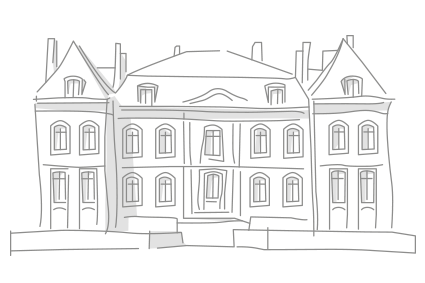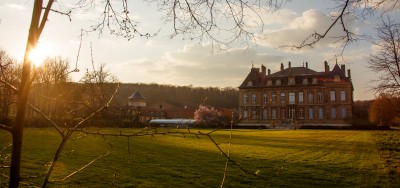The château de la Grange is not a museum: it is a full-time home for its owners who are delighted to welcome visitors. It houses a remarkable collection of 18th century furniture as well as several family portraits by Rigaud, Mme Vigée-Lebrun, Vestier and Drouais.
Other treasures include stunning Flanders tapestries,
Korean and Chinese ceramics (in celadon) and fine china in the floral “Old Luxemburg”.
The pride of the house is a magnificent and highly unusual, 5-metre stove
that was produced in the La Grange original pottery.

 |
From the early Middles Ages to the end of the 17th century, La Grange was transferred between different Luxemburg families either through marriage or inheritance without ever being sold. It was first sold in 1700 when it was bought by Brice Gomé des Hasards,Counsellor at the Parliament of Metz, whose son Christophe would, following plans by Robert de Cotte, build the castle as it stands today. Christophe Gomé des Hasards however was forced to sell La Grange in 1750 when he found himself facing financial ruin. The new owner was the Marquis de Fouquet, the King’s Lieutenant General in the Pays Messin, a distant cousin of the Maréchal de Belle-Isle who was the grandson of Nicolas Fouquet, the famous finance minister of Louis XIV who built the Vaux-le-Vicomte castle. The current owners of La Grange are direct descendants of the Marquis de Fouquet.
|

Is a contemporary creation by Franck Neau. A large lawn extends before the castle’s south facade.
It is bordered by grassland planted with Graminaceae and white flowers. On both sides of this grassland the visitor can stroll through plant rooms filled with box and large herbaceous annuals and perennial plants. Framing the central strip are two “porcelain alleys” in black stone with integrated squares of blue and red porcelain reminding the visitor of the pottery that existed here in the 18th century.
On the northern side, the “cour d’honneur” contains eight flower beds planted with white flowers. Beyond the moat, the lily garden is comprised of rows of tall box between which, in season, millions of different coloured lilies and daylilies flower. A collection of around one hundred different species of box is dispersed in the garden’s undergrowth.
The Jardin des Prairiales is a member of the “Jardins sans limites” [Gardens without Frontiers], a network which includes some twenty gardens in Moselle, Luxemburg and Sarre.
It was created with support from the Moselle Departmental Council and European funding.

04/03/2025